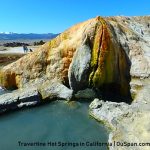
Man’s relationship with natural hot springs goes back for millennia when it was as simple as plunging into a pool of steaming water for bathing and relaxation or going as far as to use hot mineral water for religious ceremonies.
Everyone from the early Romans and ancient Japanese to the Native Americans scrambled for some water from hot springs because they believed that it held mystical healing and spiritual powers. This belief made mineral hot springs so popular and revered in some parts of the world that they became preserved for higher classes. In Japan, for example, samurai and merchants would not be allowed to bathe in the same pool.
Romans, Egyptians, and Greeks made special pools for bathing both communally and privately. The Aegean people designed special bathtubs for personal cleanliness and specified that some natural pools were blessed by the Gods to provide healing. The Romans really valued bathing as a social activity which is why they built complex baths to support their pastime. Water was heated on large log fires and fed into the public baths through channels so people could immerse in hot mineral water. To these communities, bathing was not simply a process of cleaning up but an elaborate ritual involving undressing, massage, sweating, and socialization.
In Europe and Japan, historians note that people visited mineral hot springs or, 'onsen’ in Japanese, with ritualistic dedication not only for relaxation but also for disease healing. Japan has a great number of hot springs that have been in existence for millions of years, and this is why those are etched in their culture. Members of the community got into the hot waters for their curative powers. Missionaries from the west were appalled by the sight of people lying naked in pools of hot water soaking in the thermal springs.
Native Americans were not left out either as they had their own relationships with the hot water that magically came out of the ground. Legend has it that the Ute Natives were once plagued by an ailment that local healers were unable to cure. However, after drinking and bathing in the waters of a pool in the San Juan River they were healed.
This is an interesting tale, but there is plenty of scientific, rather than anecdotal evidence on the benefits of hot springs for wellness and health. Studies of our forefathers’ lifestyle shed light on some habits that we can adopt for our own benefit. Historians and scientists, for example, have succeeded in connecting some dots between mineral hot springs and good health. This has led to the development of balneology that is a study of the therapeutic effects of bathing in mineral springs.
Related
 Mineral Springs Healing Properties
Mineral Springs Healing Properties
Since the time people have been on the Earth, soaking in mineral-rich hot springs is nothing new...
 Hot Springs Benefits & Contraindications
Hot Springs Benefits & Contraindications
Imagine soaking in your bathtub, the serenity, the peace, that sensation of all your tension and stress are just melting away...
 Balneology & Balneotherapy – Soaking for Health
Balneology & Balneotherapy – Soaking for Health
It was not long before one Tokyo doctor began to associate daily bathing in the hot springs to good health...
 Hot Springs Risks and Safety Tips
Hot Springs Risks and Safety Tips
However, while mineral hot springs offers numerous health benefits, there are some things to be cautious about...



